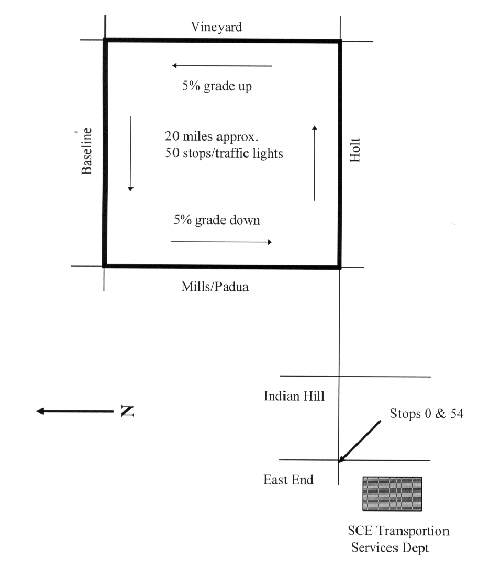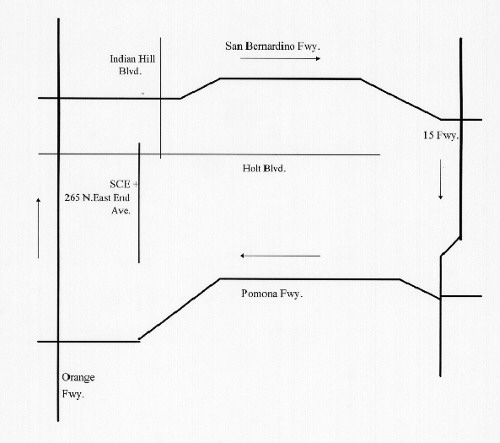

|
|
||||||||
|
|
|||||||||
At the September 1997 EV1 Club meeting we were treated to a fascinating overview of SCE's electric vehicle testing program, which is conducted by SCE's EV Technical Center in Pomona.
The EV Technical Center has devised two routes for characterizing the performance of electric vehicles.
For EV1 owners trying the routes, it may be more practical to start and end each run at the SCE facility's MagneCharger unit, using the charger to display percentage charge before and after the test run.
Note: The facility has two chargers. However they are in a secured parking lot and are frequently in use, so prior arrangement is necessary to gain access.
Thanks to SCE's Michel Wehrey and Jordan Smith for providing the maps and information.

Note: the leg from Baseline to Holt consists of Padua, then Claremont Blvd, then Mills.
Stop No. Cum. Dist. Type Dist (miles) Comments 0 0.00 light 0.00 East End and Holt 1 0.10 light 0.10 2 0.15 light 0.05 Mills and Holt 3 0.80 light 0.65 4 1.30 light 0.50 5 1.80 light 0.50 6 2.30 light 0.50 7 2.90 light 0.60 8 3.50 light 0.60 9 3.70 light 0.20 10 4.00 light 0.30 11 4.01 light 0.01 12 4.30 light 0.29 13 4.60 light 0.30 14 4.80 light 0.20 15 4.82 light 0.02 16 5.30 light 0.48 17 6.30 light 1.00 Vineyard and Holt 18 6.66 light 0.36 19 6.70 light 0.04 20 6.80 light 0.10 21 6.90 light 0.10 22 7.30 light 0.40 23 7.80 light 0.50 24 8.30 light 0.50 25 8.60 light 0.30 26 8.80 light 0.20 27 9.30 light 0.50 28 9.50 light 0.20 29 9.60 light 0.10 30 9.70 light 0.10 31 10.40 light 0.70 Vineyard and Baseline 32 10.70 light 0.30 33 10.90 light 0.20 34 11.60 light 0.70 35 11.90 light 0.30 36 12.30 light 0.40 37 12.50 light 0.20 38 12.70 light 0.20 39 13.00 light 0.30 40 13.60 light 0.60 41 14.10 light 0.50 42 15.20 light 1.10 Baseline and Padua 43 16.30 light 1.10 44 16.80 light 0.50 45 17.10 sign 0.30 46 17.40 light 0.30 47 17.60 sign 0.20 48 18.60 light 1.00 49 18.70 sign 0.10 50 19.00 sign 0.30 51 19.30 light 0.30 52 19.50 light 0.20 Holt and Mills 53 19.60 light 0.10 54 19.80 light 0.20 Holt and East End

Start at the Indian Hill onramp to the eastbound San Bernardino Freeway. Maintain speed at 65 mph when possible. Take the I15 Freeway south, Pomona Freeway west, then exit at Diamond Bar Blvd to enter the northbound Orange Freeway. Continue to the eastbound San Bernardino Freeway to complete the loop at Indian Hill Blvd.
Santa Monica City Hall to Lindbergh Field, San Diego and return.
300 miles round trip, block time six hours **each way**.
Chargers used: Irvine Texaco; Scripps Hospital (Genessee); Mission Valley Center (RON); Oceanside (Saturn); Cerritos (Saturn).
Speed: varying between 52 and 58 mph, average 55 mph. No a/c, no radio, no vent, windows cracked, cruise control on, regen on, 2 pax, light bags, light winds.
Optimum speed for minimum block time, given route and charge rates experienced: 50 mph; however, 55 mph average selected for safety reasons with block time penalty of only about 10 minutes each way.
Lessons learned: should have waited for 85% charge at Irvine Texaco vs. 81% (worst hills from Del Mar to La Jolla, needed booster charge at Scripps in La Jolla after getting "three diamonds"; all downhill shortly thereafter).
Moral: NiMH would have cut block time in half. Next time I'll fly!
Hope you find this interesting...
Geoff
I worked up an Excel spreadsheet to see how block time varies with vehicle speed, range, trip distance, and charge rate.
T = block time
V = average speed
t = time to restore full charge
D = trip distance
R = range on full charge = R(V)
then T = D/V + t*((D/R)-1)
This assumes departing with a full charge and arriving empty, the optimum condition timewise.
I used a linear approximation of R(V), matched to my observations for range at 45, 55, 65 mph. Granted, a linear fit is inaccurate, but but good enough for my range of interest. Then I cranked "Solver" to minimize block time. Then I differentiated T above by hand to verify the Solver results.
After all this effort, I came up with a result that maybe should have been obvious! The optimum speed for minimum block time is that at which energy discharge rate (on the road) is equal to energy recharge rate (on the charger). My best approximation of the EV-1/magnecharge characteristics results in an optimum at a speed of 41 mph, closer to the real world max range speed than I would have guessed.
What needs to be done? There is little prospect for major reductions in discharge rate in real world driving. The EV-1 is pretty good in that department! But can charge rates be improved?
Consider a car with 100 miles range out of a 16 kWH pack at an average 65 mph. This equates to an energy usage of 160 W/mi. What charge rate results in this speed being the optimum for minimum block time? 100/65 = 1.54 hours for a full 16 kWH charge, achievable with a 50 amp charge circuit.
Interestingly, this is what Alan Cocconi's cars do. Not by design, since he is going down the "hybrid trailer" path for long distance trips. Just serendipity. In fact, if an 80 amp outlet is available, his minimum block time speed is probably about 90 mph! My understanding of the current Magnecharge system is that the inductive paddle system is waste-heat limited to maybe 35 amps tops.
Now consider NiMH batteries. Neither discharge nor recharge rates have changed, so the optimum speed is still close to 40 mph. The only benefit accrues from the "full charge depart, empty charge arrive" assumption - this causes any longer-range car to spend less time on the charger, with diminishing benefit as trip lengths increase (since only the trip end-points are affected).
All of this is only relevant to long trips, and there is no doubt that NiMH will be a boon for intermediate length trips (50-100 miles). No one is going to be commuting to San Diego from LA in an EV on a daily basis, anyway!
On my trip to San Diego, I had a crazy desire for 2 charge ports on my EV-1... since I was the only EV-1 at each charge site, I could then have plugged in to both available chargers at each site, doubling my charge rate that way! Not elegant, but very effective!
Geoff
|
|
|||||||||

|
Return to the EV1 Club Home Page |
||||||||